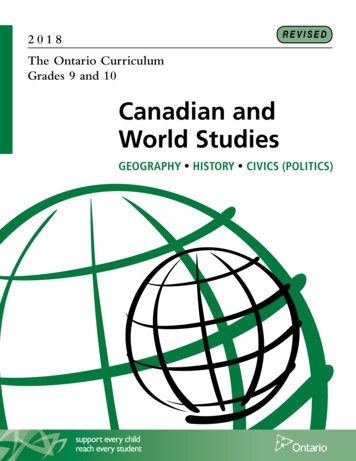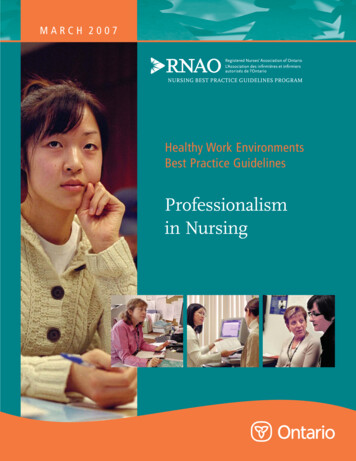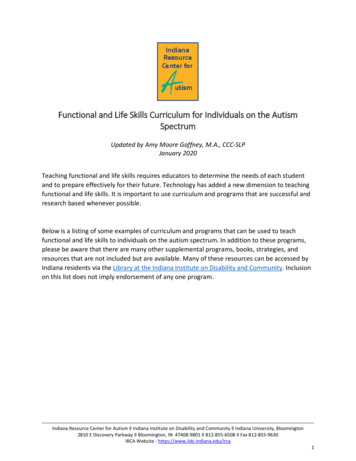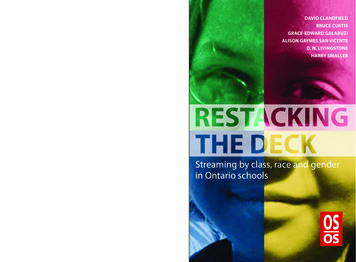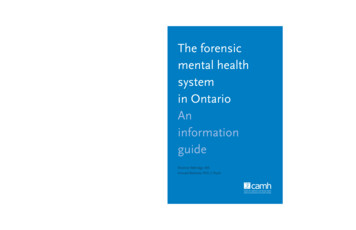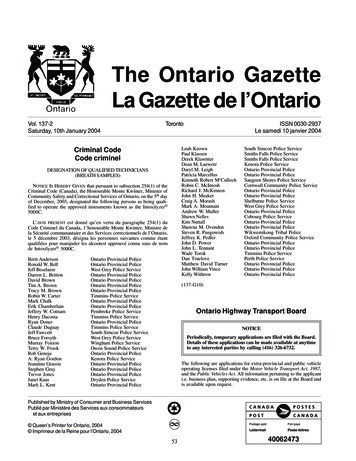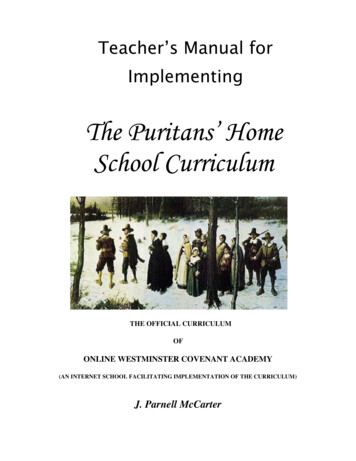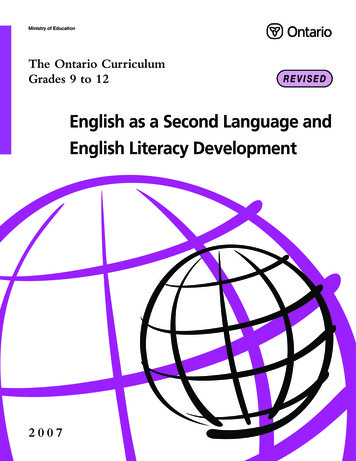
Transcription
Ministry of EducationThe Ontario CurriculumGrades 9 to 12REVISEDEnglish as a Second Language andEnglish Literacy Development2007
CONTENTSINTRODUCTION3Secondary Schools for the Twenty-first Century . . . . . . . . . . . . . . . . . . . . . . . . . . . . . . . . . . . . . . . . . . . . 3The Importance of English as a Second Language (ESL) andEnglish Literacy Development (ELD) in the Curriculum . . . . . . . . . . . . . . . . . . . . . . . . . . . . . . . . . . . 3The Goals of the ESL and ELD Curriculum . . . . . . . . . . . . . . . . . . . . . . . . . . . . . . . . . . . . . . . . . . . . . . . . . . . . 3English Language Learners in Ontario . . . . . . . . . . . . . . . . . . . . . . . . . . . . . . . . . . . . . . . . . . . . . . . . . . . . . . . . 5Programs to Support English Language Learners . . . . . . . . . . . . . . . . . . . . . . . . . . . . . . . . . . . . . . . . . . 6Roles and Responsibilities in ESL and ELD Programs . . . . . . . . . . . . . . . . . . . . . . . . . . . . . . . . . . . . . . 6Factors in Successful English Language Acquisition . . . . . . . . . . . . . . . . . . . . . . . . . . . . . . . . . . . . . . . .9THE PROGRAM IN ENGLISH AS A SECOND LANGUAGEAND ENGLISH LITERACY DEVELOPMENT12Overview of the Program . . . . . . . . . . . . . . . . . . . . . . . . . . . . . . . . . . . . . . . . . . . . . . . . . . . . . . . . . . . . . . . . . . . . . . 12Curriculum Expectations . . . . . . . . . . . . . . . . . . . . . . . . . . . . . . . . . . . . . . . . . . . . . . . . . . . . . . . . . . . . . . . . . . . . . . . 15Strands . . . . . . . . . . . . . . . . . . . . . . . . . . . . . . . . . . . . . . . . . . . . . . . . . . . . . . . . . . . . . . . . . . . . . . . . . . . . . . . . . . . . . . . . . . . . . .16Adapting ESL or ELD Courses for Students Who Speak a Variety of English . . . . . . . . 21Procedures for Placing English Language Learners . . . . . . . . . . . . . . . . . . . . . . . . . . . . . . . . . . . . . . .22Transition From Elementary to Secondary School . . . . . . . . . . . . . . . . . . . . . . . . . . . . . . . . . . . . . . . . 26Transition to Mainstream English Courses . . . . . . . . . . . . . . . . . . . . . . . . . . . . . . . . . . . . . . . . . . . . . . . . . . 26Integration of Students Into Mainstream Subject Classrooms . . . . . . . . . . . . . . . . . . . . . . . . . .27Program Delivery . . . . . . . . . . . . . . . . . . . . . . . . . . . . . . . . . . . . . . . . . . . . . . . . . . . . . . . . . . . . . . . . . . . . . . . . . . . . . . . . . 28ASSESSMENT AND EVALUATION OFSTUDENT ACHIEVEMENT31Basic Considerations . . . . . . . . . . . . . . . . . . . . . . . . . . . . . . . . . . . . . . . . . . . . . . . . . . . . . . . . . . . . . . . . . . . . . . . . . . . . 31The Achievement Chart for ESL and ELD . . . . . . . . . . . . . . . . . . . . . . . . . . . . . . . . . . . . . . . . . . . . . . . . . . . 33Evaluation and Reporting of Student Achievement . . . . . . . . . . . . . . . . . . . . . . . . . . . . . . . . . . . . . . 34Reporting on Demonstrated Learning Skills . . . . . . . . . . . . . . . . . . . . . . . . . . . . . . . . . . . . . . . . . . . . . . . 35This publication is available on the Ministry of Education’swebsite, at www.edu.gov.on.ca.
SOME CONSIDERATIONS FOR PROGRAMPLANNING IN ESL AND ELD38Instructional Approaches and Teaching Strategies . . . . . . . . . . . . . . . . . . . . . . . . . . . . . . . . . . . . . . 38Planning ESL and ELD Programs for Students With SpecialEducation Needs . . . . . . . . . . . . . . . . . . . . . . . . . . . . . . . . . . . . . . . . . . . . . . . . . . . . . . . . . . . . . . . . . . . . . . . . . . . . . . . . . 48Antidiscrimination Education in Programs for EnglishLanguage Learners . . . . . . . . . . . . . . . . . . . . . . . . . . . . . . . . . . . . . . . . . . . . . . . . . . . . . . . . . . . . . . . . . . . . . . . . . . . . . . 51Literacy, Mathematical Literacy, and Inquiry/Research Skills . . . . . . . . . . . . . . . . . . . . . . . . . . . 52The Role of the School Library in ESL and ELD Programs . . . . . . . . . . . . . . . . . . . . . . . . . . . . . . 53The Role of Technology in ESL and ELD Programs . . . . . . . . . . . . . . . . . . . . . . . . . . . . . . . . . . . . . . . 53Career Education . . . . . . . . . . . . . . . . . . . . . . . . . . . . . . . . . . . . . . . . . . . . . . . . . . . . . . . . . . . . . . . . . . . . . . . . . . . . . . . . 54Cooperative Education . . . . . . . . . . . . . . . . . . . . . . . . . . . . . . . . . . . . . . . . . . . . . . . . . . . . . . . . . . . . . . . . . . . . . . . . . 54The Ontario Skills Passport and Essential Skills . . . . . . . . . . . . . . . . . . . . . . . . . . . . . . . . . . . . . . . . . . . 55Health and Safety in ESL and ELD . . . . . . . . . . . . . . . . . . . . . . . . . . . . . . . . . . . . . . . . . . . . . . . . . . . . . . . . . . . . .56COURSES57English as a Second Language, ESL Level 1, Open (ESLAO) . . . . . . . . . . . . . . . . . . . . . . . . . . . . 59English as a Second Language, ESL Level 2, Open (ESLBO) . . . . . . . . . . . . . . . . . . . . . . . . . . . . . 71English as a Second Language, ESL Level 3, Open (ESLCO) . . . . . . . . . . . . . . . . . . . . . . . . . . . . . 83English as a Second Language, ESL Level 4, Open (ESLDO) . . . . . . . . . . . . . . . . . . . . . . . . . . . . 95English as a Second Language, ESL Level 5, Open (ESLEO) . . . . . . . . . . . . . . . . . . . . . . . . . . . 107English Literacy Development, ELD Level 1, Open (ELDAO) . . . . . . . . . . . . . . . . . . . . . . . . . . 119English Literacy Development, ELD Level 2, Open (ELDBO) . . . . . . . . . . . . . . . . . . . . . . . . . . 131English Literacy Development, ELD Level 3, Open (ELDCO) . . . . . . . . . . . . . . . . . . . . . . . . . . 143English Literacy Development, ELD Level 4, Open (ELDDO) . . . . . . . . . . . . . . . . . . . . . . . . . . 153English Literacy Development, ELD Level 5, Open (ELDEO) . . . . . . . . . . . . . . . . . . . . . . . . . . 163GLOSSARY175
INTRODUCTIONThis document replaces The Ontario Curriculum, Grades 9 to 12: English as a Second Languageand English Literacy Development, 1999. Beginning in September 2007, all courses in Englishas a Second Language (ESL) and English Literacy Development (ELD) for Grades 9 to 12will be based on the expectations outlined in this document.SECONDARY SCHOOLS FOR THE TWENTY-FIRST CENTURYThe goal of Ontario secondary schools is to support high-quality learning while givingindividual students the opportunity to choose programs that suit their skills and interests.The updated Ontario curriculum, in combination with a broader range of learningoptions outside traditional classroom instruction, will enable students to better customizetheir high school education and improve their prospects for success in school and in life.THE IMPORTANCE OF ENGLISH AS A SECOND LANGUAGE (ESL) ANDENGLISH LITERACY DEVELOPMENT (ELD) IN THE CURRICULUMOntario secondary schools are now home to students who speak more than 100 differentlanguages, including several Aboriginal languages, many African, Asian, and Europeanlanguages, or an English-related creole language (such as Caribbean Creole or WestAfrican Krio). Ontario’s increasing linguistic and cultural diversity provides studentswith many opportunities for cultural enrichment and for learning that is global in scope.At the same time, however, this diversity means that a significant and growing proportionof Ontario students arrive in English-language schools as English language learners –that is, students who are learning the language of instruction at the same time as theyare learning the curriculum. The curriculum in English as a Second Language andEnglish Literacy Development for Grades 9 to 12 has been developed to ensure thatEnglish language learners have the maximum opportunity to become proficient inEnglish and achieve the high levels of literacy that are expected of all Ontario students.THE GOALS OF THE ESL AND ELD CURRICULUMThe ESL and ELD curriculum is based on the belief that broad proficiency in English isessential to students’ success in both their social and academic lives, and to their abilityto take their place in society as responsible and productive citizens. The curriculum isdesigned to provide English language learners with the knowledge and skills they need
to achieve these goals. Its aim is to help students become successful English languagelearners who can:use English to communicate effectively in a variety of social settings;use English to achieve academically in all subject areas;take charge of their own learning, independently and in groups;select and use effective learning strategies;integrate confidently into mainstream courses;use English effectively to advocate for themselves in all areas of their lives;make a successful transition to their chosen postsecondary destination (work,apprenticeship, college, university);function effectively in a society increasingly committed to the use of informationtechnology;use critical-literacy and critical-thinking skills to interpret the world around them;participate fully in the social, economic, political, and cultural life of theircommunities and of Canada.This culminating vision of successful English language learners identifies the languageskills and capabilities required for success in Ontario’s education system and for fullparticipation in Canadian society. The expectations outlined in the ESL and ELD curriculum are designed to enable students to develop these important skills and capabilities.THE ONTARIO CURRICULUM, GRADES 9 –12 ESL and ELDFor many English language learners, achievement of the expectations may require themto adopt new ways of learning and new ways of interacting with others. However, growthtowards full linguistic and cultural competence in English should not be at the expenseof students’ own languages and cultures. A major goal of any instructional program forEnglish language learners should be to encourage students to value and maintain theirown linguistic and cultural identities so that they can enter the larger society as bilingualand bicultural individuals. Such young people are able to choose language and culturalnorms that are appropriate in any given situation or cultural context, and can fully participate in and contribute to our multilingual, multicultural Canadian society.4The ESL and ELD curriculum expectations are designed to help English language learnersdevelop the skills they need to develop proficiency in everyday English and, most especially, the proficiency in academic English that will allow them to integrate successfullyinto the mainstream school program. It is important to recognize that while English language learners are in the process of acquiring academic language, their age peers are notstanding still in their learning of grade-appropriate language and concepts. In effect,English language learners must catch up with a moving target. Thus, an effective curriculum for English language learners integrates academic language and literacy skills withsubject-matter concepts and critical-thinking skills from the very beginning levels ofinstruction, so that students can gain as much momentum as possible as they progressto full participation in mainstream classes in the various subjects.
ENGLISH LANGUAGE LEARNERS IN ONTARIOEnglish language learners are students in provincially funded English-language schoolswhose first language is a language other than English, or is a variety of English that issignificantly different from the variety used for instruction in Ontario’s schools, andwho may require focused educational support to assist them in attaining proficiencyin English. They may be Canadian-born or recently arrived from other countries. Theycome from diverse backgrounds and school experiences, and have a variety of strengthsand needs.Newcomers to Ontario. Newcomers to Ontario from countries around the world mayarrive at any point between Grade 9 and Grade 12. They may enter school at the beginning of the school year or at any time during the year. The level of support newcomersrequire to succeed in the classroom will depend on their age, country of origin, and previous educational experience. Some newcomers arrive in Canada with their families aspart of a voluntary, planned immigration process. These students have usually receivedformal education in their countries of origin, and some may have studied English as aforeign language. Some newcomers arrive in Canada under more urgent conditions: forexample, fleeing crises in their homelands. These young people have often suffered traumatic experiences, and some may have been separated from family members. They mayhave been in transit for a few years, and they may or may not have had access to formaleducation in their homeland or while in transit.International or Visa Students. International or visa students are usually of secondaryschool age, although some may arrive earlier. They pay fees to attend school in Ontario,and often plan to attend a Canadian college or university. These students typically arrivein Canada without their families. They may live with older siblings, with members of theextended family, or under the care of a guardian or home-stay program; older studentsmay live alone. Many have had some instruction in English; nevertheless, they often needconsiderable support to develop the level of English proficiency required for success inOntario schools.Canadian-Born Students. Most English language learners entering secondary schoolare newcomers from other countries; however, others are Canadian-born, such as thefollowing:learners returning from a prolonged stay in another country where they receivededucation in a language other than English;learners from Aboriginal communities who speak a first language other thanEnglish;learners from communities that have maintained distinct cultural and linguistictraditions who choose to enter English-language schools and who have a first language other than English.INTRODUCTION5
Students With Limited Prior Schooling. Although all countries have schools that offer anexcellent education, some English language learners have not had access to such schoolsfor economic, political, ideological, or geographic reasons. The following are some reasonswhy some English language learners may have had limited opportunities for education:Some countries invest most of their resources in a small percentage of “top” students,who may be selected through examinations for entrance to schools offering highquality educational programs. Other students, including many of high potential,may not have this kind of opportunity.In some countries only those parents who can afford school fees can ensure a highquality education for their children. Children in rural areas may have to travellong distances, often on foot, to get to school, and roads may be impassable atsome times of the year. In some countries, education has been severely disruptedor even suspended completely during periods of war or civil conflict. In somecountries, gender, social class, religion, or ideology may limit access to schooling.Some children may have spent several years in transit before arriving in Canada,and may have had little or no access to schooling during that time.PROGRAMS TO SUPPORT ENGLISH LANGUAGE LEARNERSSecondary school ESL and ELD programs are generally intended to support newcomers.For their first few years in Ontario schools, many English language learners receivesupport in one of the following two distinct programs designed to meet their languagelearning needs and/or to help them develop the literacy skills they need in order tocontinue their education and participate fully in life in Ontario:THE ONTARIO CURRICULUM, GRADES 9 –12 ESL and ELDEnglish as a Second Language (ESL) programs are intended for students whose firstlanguage is a language other than English or is a variety of English significantlydifferent from that used for instruction in Ontario schools. Students in theseprograms have age-appropriate first-language literacy skills and educationalbackgrounds.6English Literacy Development (ELD) programs are intended for students whosefirst language is a language other than English or is a variety of English significantly different from that used for instruction in Ontario schools. Students in theseprograms are most often from countries in which their access to education hasbeen limited, so that they have had limited opportunities to develop languageand literacy skills in any language. Schooling in their countries of origin has beeninconsistent, disrupted, or even completely unavailable throughout the years thatthese children would otherwise have been in school. As a result, they arrive inOntario secondary schools with significant gaps in their education.ROLES AND RESPONSIBILITIES IN ESL AND ELD PROGRAMSCreating a welcoming and inclusive school environment for English language learners isa whole-school activity requiring the commitment of administrators, teachers, supportstaff, and other leaders within the school community. The reward for this committedeffort is a dynamic and vibrant school environment that celebrates diversity as an assetand enriches the learning experience of all students.
StudentsStudents have many responsibilities with regard to their learning. Students who are ableto make the effort required to succeed in school and who are able to apply themselveswill soon discover that there is a direct relationship between this effort and their achievement, and will therefore be more motivated to work. There will be some students, however, who will find it more difficult to take responsibility for their learning because ofspecial challenges they face. The attention, patience, and encouragement of teachers canbe extremely important to these students’ success. However, taking responsibility fortheir own progress and learning is an important part of education for all students,regardless of their circumstances.Mastery of concepts and skills in the ESL and ELD curriculum requires a sincere commitment to work, study, and the development of appropriate skills. Furthermore, studentsshould be encouraged to actively pursue opportunities outside the classroom to extendtheir proficiency in English and enrich their understanding of the language. Their mastery of English will grow as they engage in real-world activities that involve listening,speaking, reading, and writing in English. Students develop their English literacy skillswhen they seek out recreational reading materials and multimedia works that relate totheir personal interests and to the various subject areas, and when they engage in conversation with parents, peers, and teachers about what they are reading, writing, andthinking in their daily lives. As well, it is important to encourage students to maintaintheir first-language skills, as their bilingual and bicultural orientation has the potentialto be a lifelong asset both to themselves and to Canadian society.ParentsParents 1 have an important role to play in supporting student learning. Studies showthat students perform better in school if their parents are involved in their education. Bybecoming familiar with the curriculum, parents can determine what is being taught inthe courses their children are taking and what their children are expected to learn. Thisawareness will enhance the ability of parents to discuss their children’s work with them,to communicate with teachers, and to ask relevant questions about their children’sprogress. Knowledge of the expectations in the various courses also helps parents tointerpret teachers’ comments on student progress and to work with teachers to improvestudent learning.Other effective ways in which parents can support their children’s learning includeattending parent-teacher interviews, participating in parent workshops, becominginvolved in school council activities (including becoming a school council member),supporting their children in completing their assignments at home, and encouragingtheir children to maintain active use of the home language.The ESL and ELD curriculum promotes awareness of the wider community. In additionto supporting regular school activities, parents can encourage their children to take anactive interest in current affairs and provide them with opportunities to question andreflect on what is happening in the world.INTRODUCTION1. In this document, parent(s) is used to mean parent(s) and guardian(s).7
TeachersTeachers and students have complementary responsibilities. Teachers are responsible fordeveloping appropriate instructional strategies to help students achieve the curriculumexpectations for their courses, as well as for developing appropriate methods for assessing and evaluating student learning. Teachers bring enthusiasm and varied teaching andassessment approaches to the classroom, addressing individual student needs andensuring sound learning opportunities for every student.Using a variety of instructional, assessment, and evaluation strategies, teachers providenumerous opportunities for students to acquire proficiency in English, as well as subjectcontent knowledge. They provide learners with frequent opportunities to practise andapply new learning and, through regular and varied assessment, give them the specificfeedback they need to further develop and refine their skills. By assigning tasks thatpromote the development of higher-order thinking skills, teachers enable students tobecome thoughtful and effective communicators in English. In addition, teachers encourage students to think out loud about their own language processes, and support themin developing the language and techniques they need to assess their own learning.Opportunities to relate knowledge and skills in English language learning to wider contexts, both across the curriculum and in the world beyond the school, motivate studentsto learn and to become lifelong learners.ESL/ELD teachers, mainstream subject teachers, teacher-librarians, special educationteachers, and guidance teachers must all work together, within the provisions outlinedin all secondary school curriculum documents, to support English language learners, tohelp them integrate successfully into the academic and social life of the school, and tohelp them learn about postsecondary pathways and destinations.PrincipalsTHE ONTARIO CURRICULUM, GRADES 9 –12 ESL and ELDThe principal works in partnership with teachers and parents to ensure that each studenthas access to the best possible educational experience. To support student learning, principals ensure that the Ontario curriculum is being properly implemented in all classroomsthrough the use of a variety of instructional approaches. They also ensure that appropriateresources are made available for teachers and students. To enhance teaching and learningin all subjects, including ESL and ELD, principals promote learning teams and work withteachers to facilitate teacher participation in professional-development activities.8Principals ensure that schools have in place procedures and practices for welcomingEnglish language learners and their families, and that schools present an inclusive andwelcoming environment for all students. As well, principals ensure that all subjectteachers incorporate appropriate adaptations and strategies into their instruction andassessment to facilitate the success of the English language learners in their classrooms.Principals are also responsible for ensuring that every student who has an IndividualEducation Plan (IEP) is receiving the modifications and/or accommodations describedin his or her plan – in other words, for ensuring that the IEP is properly developed,implemented, and monitored.
Community PartnersCommunity partners can be an important resource in students’ language development.They can provide support for students with literacy needs, both in the classroom and asliving models of how the curriculum relates to life beyond school. Such modelling andmentoring can enrich not only the educational experience of students but also the life ofthe community.Schools and school boards can play a role by coordinating efforts with community partners. They can involve community volunteers in supporting language instruction andin promoting a focus on literacy in and outside the school. Community partners can beincluded in literacy events held in the school, and school boards can collaborate withleaders of existing community-based literacy programs for youth, including programsoffered in public libraries and community centres. Partnerships with local settlementagencies and ethnocultural organizations are also a valuable resource for both educatorsand English language learners and their families.FACTORS IN SUCCESSFUL ENGLISH LANGUAGE ACQUISITIONResearch studies show that it takes five or more years for most English language learnersto catch up to age peers in using English for academic purposes, although some willaccomplish this earlier, and some will need much longer. Most English language learnersare able to function effectively and confidently in everyday language situations within ayear or two. For example, they can follow classroom directions and maintain simple conversations about familiar topics and routines. During this time they also acquire a basicvocabulary of high-frequency words and phrases (such as friend, hungry, “Say it again,please.”). However, it can take much longer for English language learners to catch up totheir age peers in academic language.General FactorsThe rate at which an English language learner acquires proficiency in English, adapts tothe new environment, and integrates into the mainstream academic program will beinfluenced by a number of general factors. Factors affecting the successful acquisition ofEnglish include the following:The acculturation process. It is acknowledged that most newcomers experience aperiod of cultural adjustment. Newly arrived students will move through thestages of acculturation at an individual pace. The rate at which individual studentsexperience the acculturation process may vary even among members of the samefamily. Some students may experience elements of different stages at the sametime; some may remain in one stage for an extended period of time or may repeatcharacteristics associated with an earlier stage if the process has been interrupted.The level of development in the first language. English language learners who are atage-appropriate levels of language and literacy development in their own languageare more successful in learning English.INTRODUCTIONThe migration experience. Many newcomer students have arrived in Canada withtheir families as part of a voluntary, planned immigration process. However, somestudents have arrived from countries in chaos, have spent time in refugee camps,or have experienced personal trauma caused by natural disaster, politicalupheaval, or family disruption.9
Prior experience with English. Some newcomers, especially those of secondary schoolage, have studied English in their own countries. Placement of these students mayvary according to their level of proficiency in English.Personality or motivational factors. Some students are more likely to seek out opportunities to use the new language and take the risks involved in experimentingwith English. Others may need encouragement and support to do this.The amount and quality of prior schooling. Students who have significant gaps intheir schooling have more to catch up on and will need more support over alonger period of time.The presence of learning exceptionalities. English language learners show the fullrange of learning exceptionalities in the same proportions as other Ontario students.When special education needs have been identified, students are eligible forESL/ELD services and special education services simultaneously.School and Classroom FactorsA number of school and classroom factors can have a positive influence on Englishlanguage acquisition. These factors include the following:The classroom environment. A caring environment where teacher and peers supportEnglish language learners and value their efforts to communicate is essential. It isalso important to validate students’ linguistic and cultural backgrounds, encouraging them to strive to become bilingual and bicultural. As well, the selection ofclassroom resources should reflect the students’ backgrounds, ages, interests, andlevel of proficiency in English.The amount and quality of ESL or ELD support. English language learners need theassistance of ESL or ELD teachers (and of classroom teachers who are aware ofand responsive to their needs as language learners) who use approaches andstrategies that are tailored to their needs (see the outline of approaches and strategies on pages 38 48).THE ONTARIO CURRICULUM, GRADES 9 –12 ESL and ELDOpportunities for interaction in English. English language learners need frequentopportunities for extended conversation in English with their peers and othermembers of the larger community. They should be encouraged to becomeinvolved in extra-curricular activities within the school community.10Supportive language feedback. English language learners need opportunities to produce language and receive feedback in a respectful and helpful way. It is important for teachers to focus on communication first, responding to the content ofwhat the student is trying to say, before rephrasing in order to provide a model forthe student. As well, it is helpful to focus on one or two errors at a time ratherthan trying to “fix” everything. Errors are a normal part of the language learningprocess.Opportunities to maintain and develop the first language. The student’s first languageis a critical foundation, not only for language learning but for all l
This document replaces The Ontario Curriculum, Grades 9 to 12: English as a Second Language and English Literacy Development, 1999. Beginning in September 2007, all courses in English as a Second Language (ESL) and English Literacy Development (ELD) for Grades 9 to 12 wil

